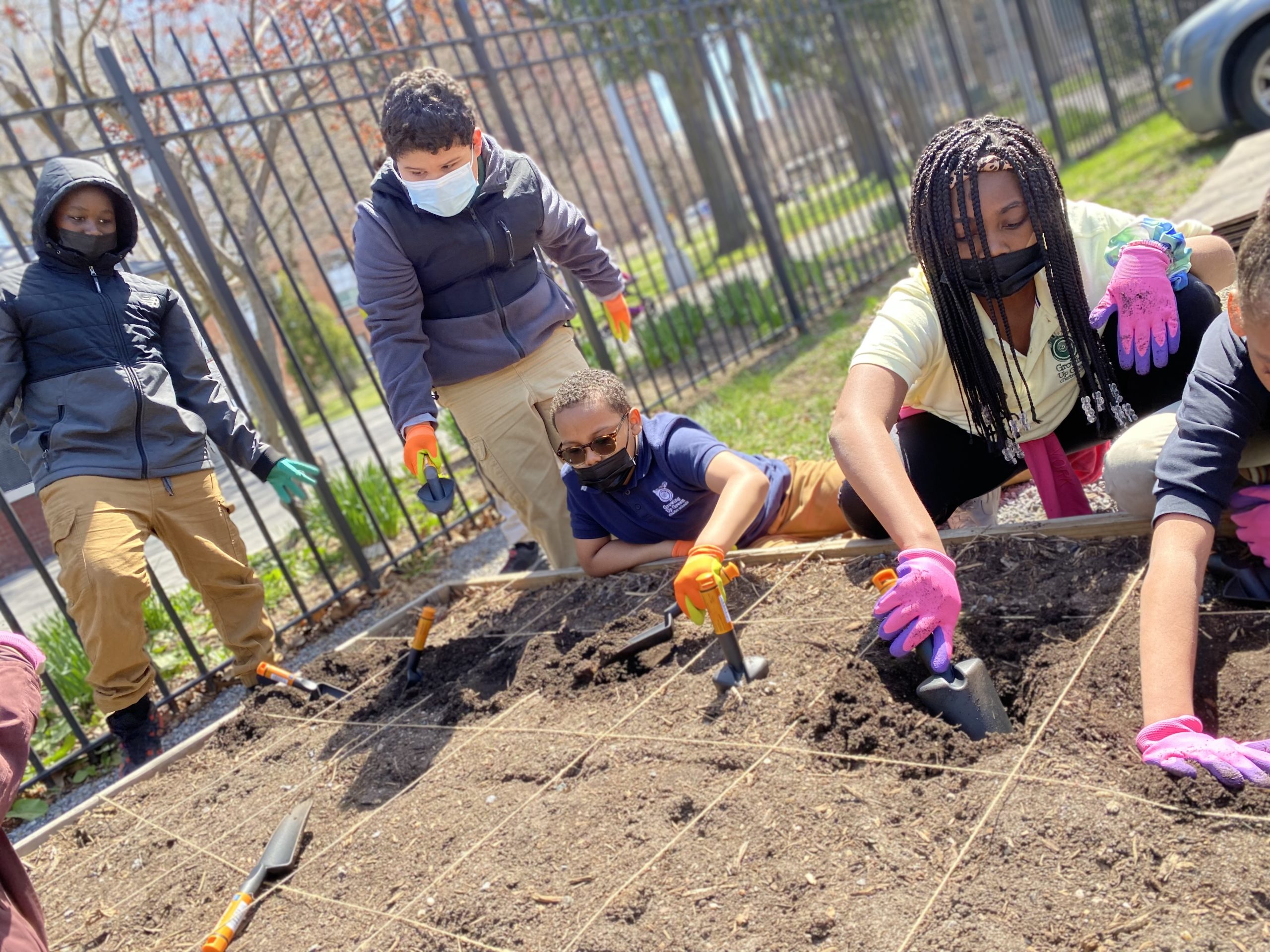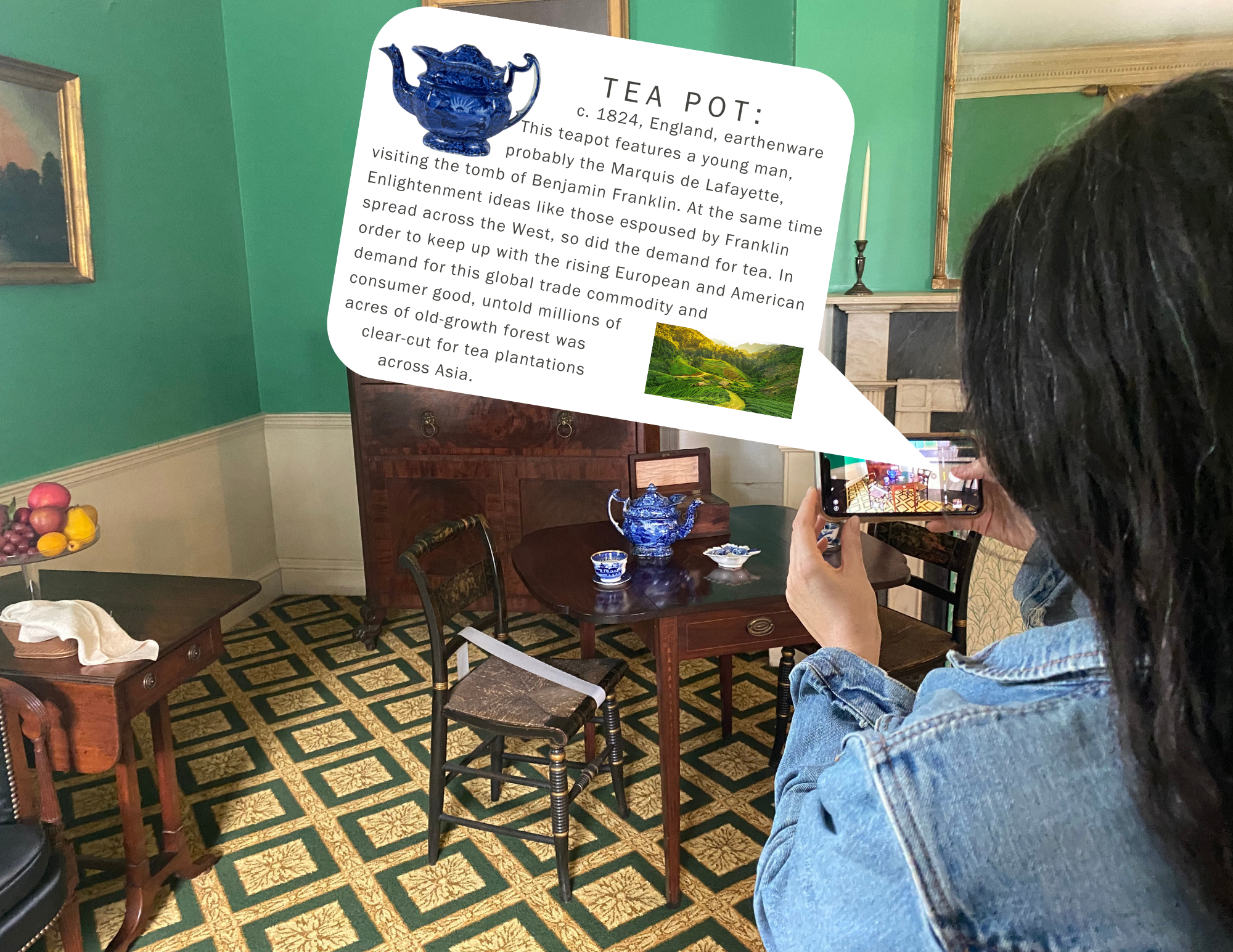Environmental Education and the Historic House
By Kelsey Brow, Executive Director, King Manor Museum
At the moment, this piece of mahogany furniture looks like a chest of drawers, or a dresser, right? But when you open this part, it drops down and becomes the writing surface for a desk. It is a classic example of Federal style furniture and some of the details, such as these fine brass keyholes that you see here, indicate that this might be a piece from the workshop of the famous furniture maker Duncan Phyfe. Phyfe and his contemporaries helped make New York the new country’s most popular and prolific market for furniture-making. The demand for their stylish furniture with beautiful mahogany veneers actually deforested the island of Barbados and caused the extinction of this species of tree in the Caribbean. The harvesting of these trees paved the way for clear-cutting of the old growth forests- which we now know are important carbon-sinks- accelerating the development sugarcane plantations as the region’s leading characteristic. Sugarcane plantations were some of the most dangerous and horrific industries reliant on enslaved labor and are also a harmful monoculture agricultural practice that leads to soil erosion and -today- increased use of chemical pesticides and fungicides as lack of biodiversity makes the crops less naturally resistant to pests and diseases.
This is the type of information you can get on a tour of King Manor—a c. 1805 historic house museum at the center of the only major green space in Jamaica, a bustling, urban neighborhood and commercial center in Queens, New York City, built on the ancestral homelands of the Canarsie and Lenape peoples. At King Manor, we have been bringing environmental education into our humanities practice for a handful of years now, through its inclusion in the narrative for public tours, but more so through our ethnobotanic teaching garden (currently stewarded by local elementary-aged children in partnership with our neighbourhood Growing Up Green Charter School) and seed library.

A c. 1850 coal-burning stove was retrofitted into the 18th century hearth by the second generation of King family to live here; coal burned slower, saving fuel, but burns dirtier. Is technological change always an improvement? (Photo: Christina Carlin, King Manor)

Students from a neighbourhood school getting ready to transplant seedlings they started in the classroom (Photo: Growing Up Green Charter School).
I’ve seen a growing number of historic house museums with extensive grounds incorporating the topic of climate change into their narrative, but only when discussing their grounds. Our global responsibility to combat climate change, however, doesn’t stop when we go inside. And at King Manor, we believe the period room is an untapped resource for environmental education. By presenting this global phenomenon in a domestic context, it becomes relatable and thus more digestible to visitors, removing barriers to entry for people who do not have a strong background in this time period, or who do not think about climate change as something that touches their daily lives. Although, of course, industry is a far bigger contributor to climate change than any individual, historic house museums present a unique opportunity for showcasing how our individual actions lead to collective outcomes that in turn contribute to climate change.
Digital Planning for the Cultural Sector, Professional Development Certificate
Position your organization to thrive in a digital economy.
This micro-credential looks at ways technology is being used in the cultural sector and gives you the in-demand knowledge and skills you need to help your organization thrive in the digital economy. Embrace the opportunity that technology in the cultural sector can offer. BC residents are eligible for 25% tuition subsidy.
Historic house museums present a different view of the past; these domestic spaces show not only how people were influenced by the world around them but also how they influenced this world. Aspects of the buildings themselves say much about how people inhabited their environment before conveniences like central heating and air conditioning. Like thick walls that retained heat inside during the winter, but prevented the summer heat from penetrating the interior; or windows designed to promote a cross breeze. The material culture of the period room also shows different patterns of consumption, with their users often being very engaged in the production processes of their belongings. Despite being hundreds of years old, many of the items in historic house museums are still fully functional, while most of ours are designed to break down every few years so we have to buy new ones. This distinction shows that things have not always been the way they currently are, which presents a hopeful narrative (especially for younger visitors with climate anxiety). That if our past choices created this world, our current and future choices can change it. Seen this way, historic house museums prompt us to ask: how can we engage differently with the world around us?
However, historic house museums are typically visitable only by guided tour. Expanding narratives mean tour guides already have to retain a lot of information, and budgetary or other logistical concerns lead many sites to employ volunteer docents, student workers, or seasonal employees. Training docents to layer in environmental history on their tours may take too long than is effective for short-term workers, and might be beyond the scale of what can—or should—be expected from volunteers.

Climate Change at Home: Detail of promotional flyer for Climate Change at Home, demonstrating how visitors can use their phones to help them access layers of information about the objects in the room through scanning hidden RFID tags. (Photo: Kelsey Brow, King Manor)
Climate Change at Home
To address these barriers, we have begun to experiment with other ways of sharing environmental information, such as Climate Change at Home. We recently launched this technology-assisted tour of the museum that allows visitors to engage with King Manor’s period rooms through the lens of environmental and climate change, by examining the materials, manufacture, and global environmental impact of our 19th-century objects.
Visitors use their smartphones (or may borrow an iPad from the front desk) to scan period rooms to discover the climate history of selected objects. As a visitor scans the room, their phone picks up input from RFID tags that are hidden inside or behind objects that curatorial and educational staff have selected for the tour. Since RFID tags can be read at a distance, this technology allows for extra layers of meaning to be hidden in period room displays without disrupting their historical setting. Once scanned, information about the climate history of these objects pops up on the phone. For instance, visitors can see how the spice trade meant an expanded palette and an expanded carbon footprint, or how an indigo-dyed blanket reminds us of early monoculture practices in the US and how this continues today, to the detriment of soil health.
By the end of the tour, visitors are able to “read” the climate history of objects in the museum on their own—and start thinking about how their everyday choices are part of a larger global phenomenon. They leave having understood climate change on a much more personal level. Our goal with this tour is to empower visitors to recognize the larger environmental histories of displayed household objects, and take this critical approach to understanding the world around them long after their museum visit is over.
While incorporating technology in our tours is quite new for us, we are hoping that it will also help visitors join in on the conversation, literally. Our tours are not scripted; rather, they are intended to be dialogues with our visitors. If visitors can access some information for themselves using their phones, it means not all of the communication is a) verbal and b) mediated by a docent. We hope this approach prompts visitors to see themselves as empowered thinkers and to share their thoughts, knowledge, and opinions with the docent and each other.
When visitors contribute to their own learning (and the museum’s!), they feel an increased ownership towards the museum. This type of reception helps keep historic house museums relevant to their communities. I hope the Climate Change at Home initiative inspires other museums to incorporate environmental education in tours of their period rooms. It’s worth noting that RFID tags are quite inexpensive, so it is a low-risk opportunity to experiment with interpretation! Now, what objects in your historic house museum have a compelling climate history?


